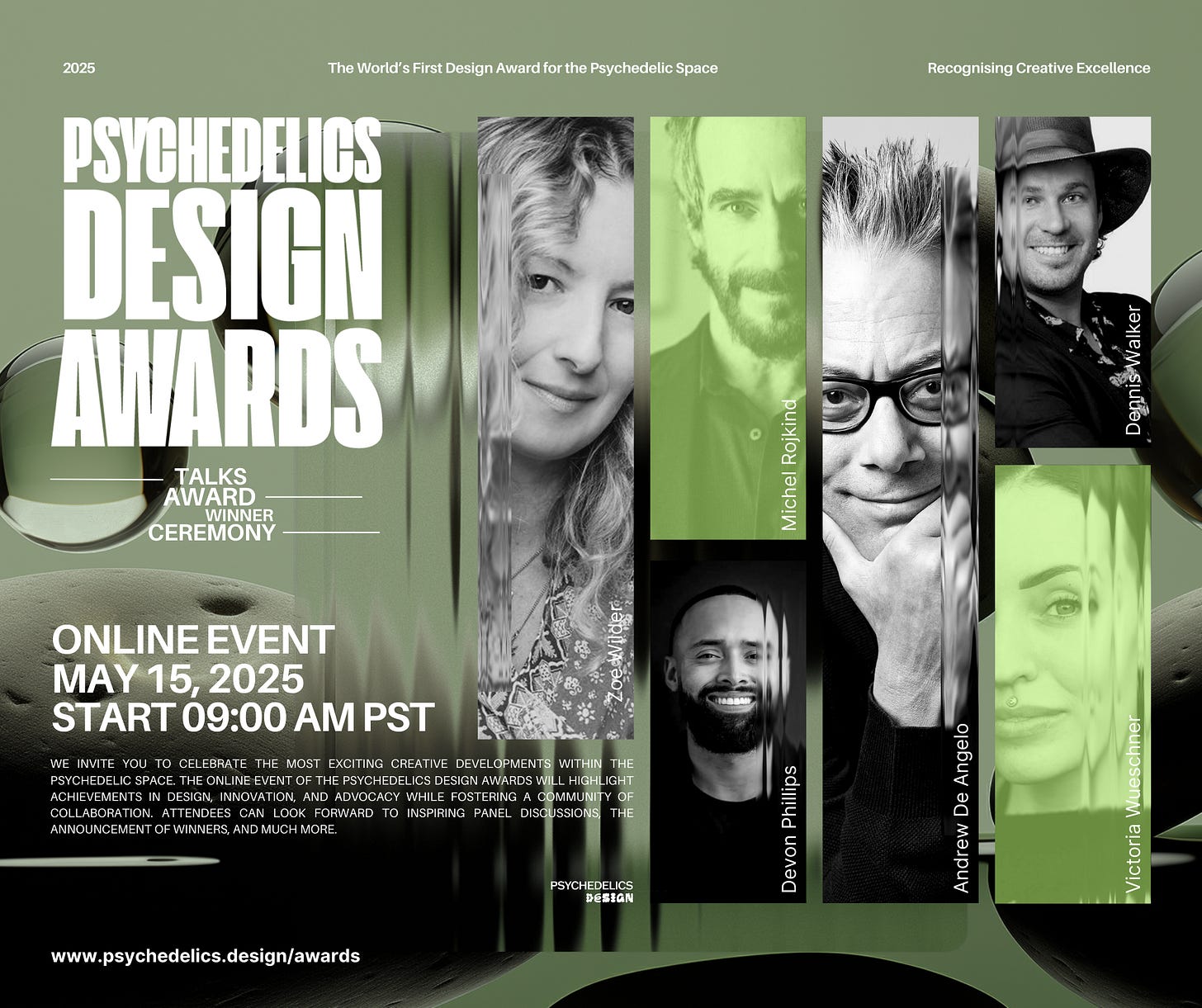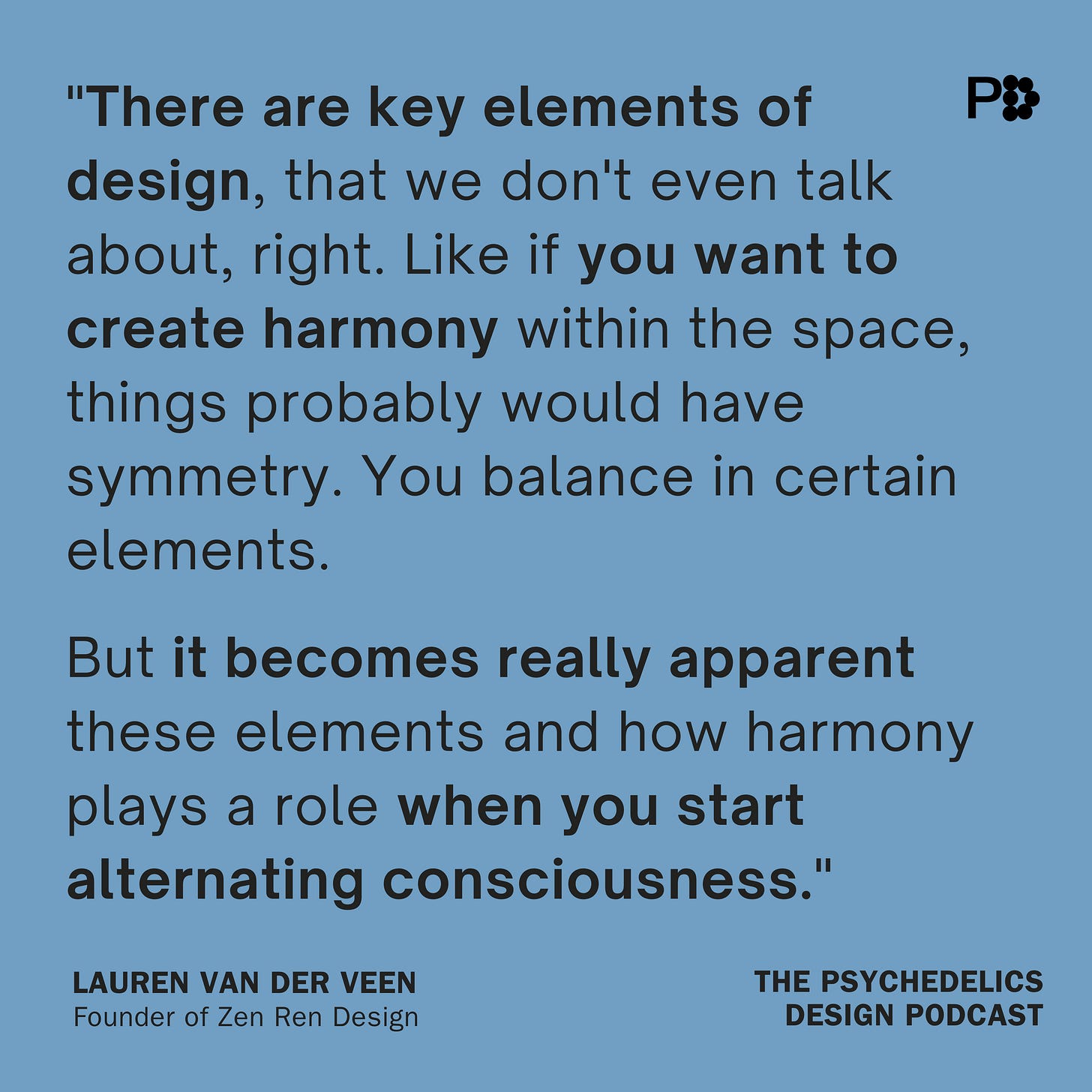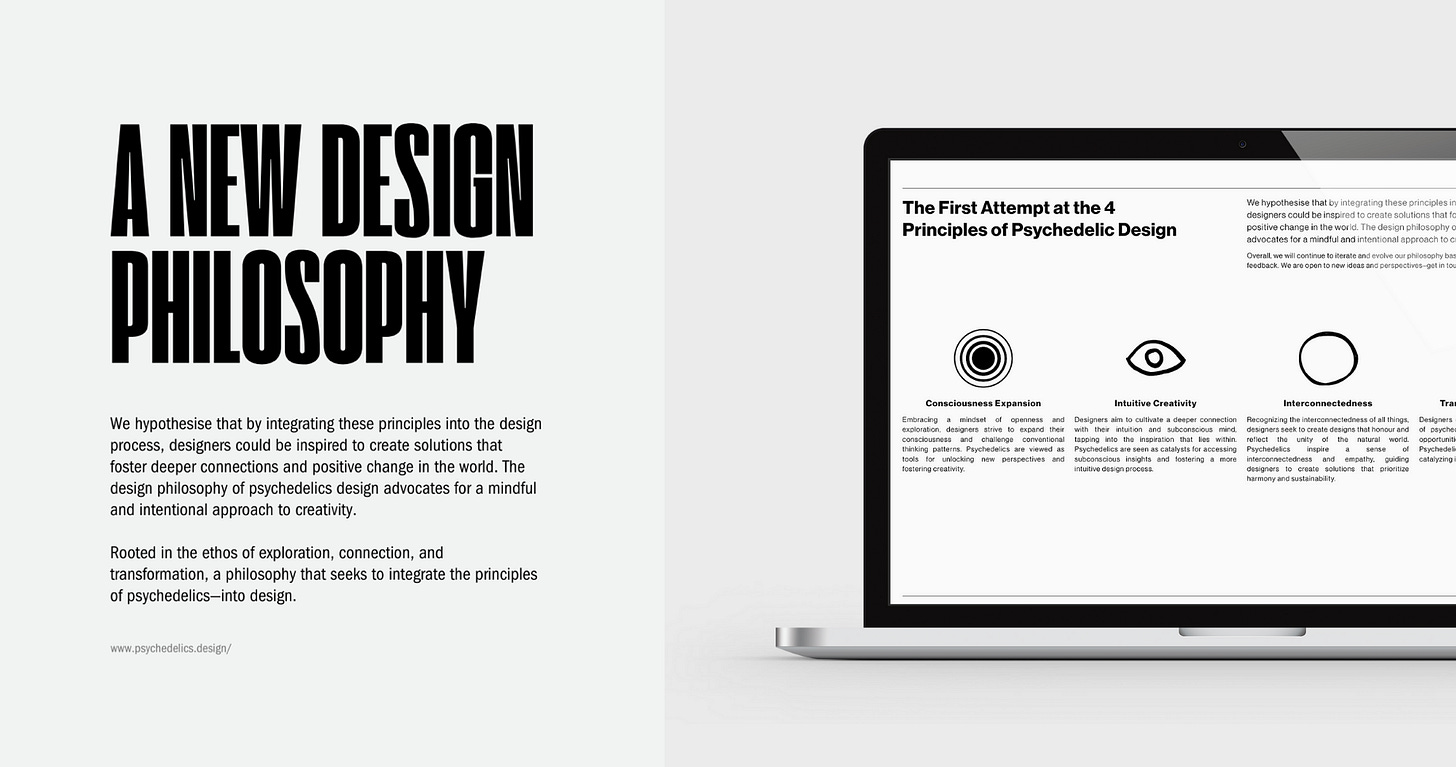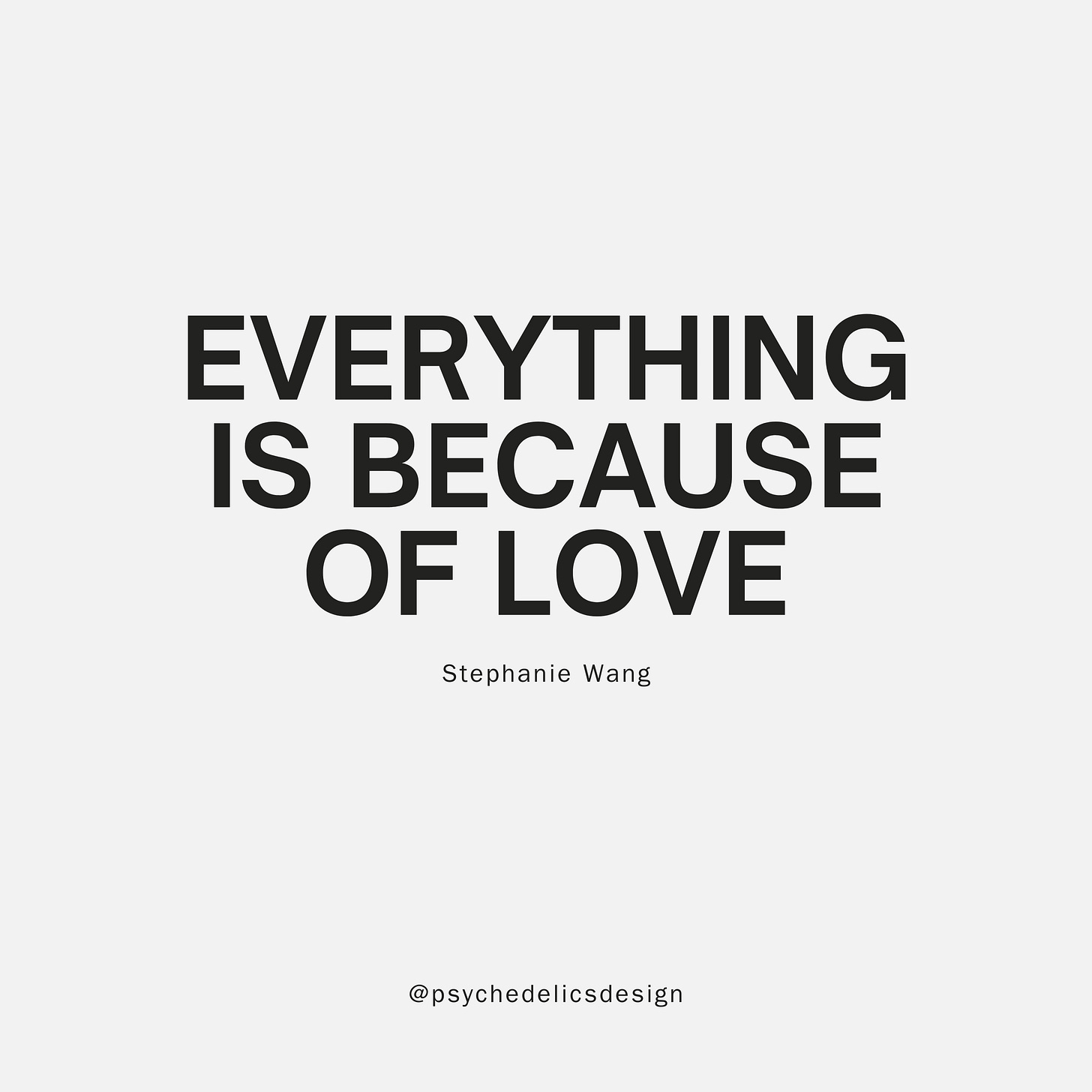Humanity is very competitive and ergo it comes as no surprise that when we talk about psychedelics, we also consider their potential for human optimisation. After all, if Steve Jobs did benefit from psychedelics, would not the average human being also be able to benefit in optimising their life–you might think. But it is not quite that simple. Can we take a step back, pause and envision a time in which altered states of consciousness induced by these substances are being studied for their ability to foster unconventional ideas, breakthrough creative blocks, and facilitate interdisciplinary connections–but in a thoughtful way, carefully designed and not only accessible to an elite?
As the design landscape becomes increasingly complex and interdisciplinary, exploring alternative methods like psychedelics could provide the fresh perspectives needed to navigate the challenges we face. But at the same time, as the psychedelic bubble is eager to grow, design can be a very powerful ally to communicate benefits and risks to a wider audience.
Psychedelics Design together with Blossom has had many open conversations with leading experts in psychedelics and design exactly at that intersection with scientists, designers, and entrepreneurs. Let’s have a look at a year of poking at the idea of integrating psychedelics and/or psychedelic-inspired design principles–let’s say ‘psychedelic design thinking’– into human creative and problem-solving processes for the betterment of not just humanity but also nature. Equally, let’s give design some credit as a tool to bring a psychedelic message out into the world.
Welcome to the ONLINE EVENT OF THE PSYCHEDELICS DESIGN AWARDS where we will highlight achievements in design, innovation, and advocacy while fostering a community of collaboration.
Look forward to inspiring panel discussions, the announcement of winners, and much more.
Early Bird Tickets are available until Feb 11, 2025 (limited availability to 50 tickets) – starting at $20.00
Please note: Everyone submitting to the awards will have free access to the online awards event!
Design Empathised by Psychedelics
Research indicates that psychedelics can reopen the social reward learning critical period. This suggests they may enhance our ability to overwrite negative social conditioning from early in life and form deeper connections with others. Improved social cognition could lead to more collaborative and inclusive approaches to innovation and problem-solving. Let’s hypothesise that we can’t help but design after psychedelic experiences in a more empathic way also how we relate to nature.
Paul Austin, founder of Third Wave, said at the Psychedelics Design Conference in July this year: “When we have this deep sense of interconnection, we can no longer build and create systems that are responsible for the discrimination of our environment because we come to realise that our health individually and collectively is intertwined and entangled with the health of our ecosystem.”
Psychedelics have been shown to increase interconnectedness across multiple domains. This research study found that, after psychedelic experiences, participants reported significant increases in total connectedness scores, as well as improvements in each of the subscales measuring connectedness to self, others, and the world. The authors suggest that psychedelics may work therapeutically by enhancing a generalized sense of connectedness, which spans across personal, social, and environmental dimensions.
“I hypothesise that the increased sense of interconnectedness could foster more holistic and systems-level thinking, which is crucial when designing products, technologies, and services. A deeper awareness of interconnectedness might naturally lead to more ethical decision-making processes, considering the wider impact of innovations on all living things. If this hypothesis holds true, it could lead to a shift from short-term, profit-driven thinking to more long-term, impact-conscious approaches in creation and design.” Alexandra Plesner
Unity with Nature
To build on that, psychedelic experiences foster a sense of unity with nature. This enhanced ecological awareness could inspire innovations and solutions that are more harmonious with the natural world. If we believe that psychedelics open new doorways, that would also mean that we have a chance to re-imagine and maybe “re-feel” from where we created in the first place. Questions such as “How can we, as architects, contribute to a world where human presence adds value to the natural environment rather than detract from it?” from Michel Rojkind (Founder Rojkind Arquitectos) would be engrained into us as designers and give us a new clean slate and place from where we start designing.
In fact, "Everything is designed,” says Tracy DeLuca (Founder of How Might We Design), “I'd say, either by humans or by nature. Obviously, humans are nature, but we don't tend to think of ourselves that way. Just that nature has the evolutionary design process like evolution is a design process. And then humans, we can make intentional or even unintentional decisions that result in how something is designed or comes to life."
“The good news is that psychedelics have a remarkable potential in healing the mind and restoring crucial lost connections.” Joe Moore (CEO and Co-Founder of Psychedelics Today) says, “Studies have shown, these substances can be bringing us back to unity and empathy.”
Ideas for psychedelics for design processes
Set and Setting – Controlled Psychedelic Experience
Set and setting are crucial factors when considering the use of psychedelics in design practices, as they significantly influence the nature and outcome of the psychedelic experience. This concept extends beyond the immediate effects of the substances to potentially shape the creative process and resulting design work.
Firstly, the "set" or mindset of the designer engaging with psychedelics can profoundly impact their creative output. A well-prepared and intentional mindset can lead to a more focused and purposeful exploration of design concepts, potentially unlocking novel ideas and perspectives. Conversely, an unprepared or anxious state of mind might result in chaotic or unfocused design thinking. The designer's expectations, intentions, and psychological state form a crucial foundation for how psychedelic insights might be translated into tangible design outcomes.
Following an incredibly generous dinner invitation by co-founder and president Dr Bruce Damer and founding director Matt Gillespie of MINDS (Center for Multidisciplinary Investigation Into Novel Discoveries & Solutions) in London this year, I was honoured to take part in cutting-edge discussions centred on the critical importance of preparation for problem-solving. We explored how the groundwork laid over weeks, months, or even years is essential in creating an environment where psychedelic experiences can catalyse breakthrough shifts in perspective and foster novel connections. This preparatory phase is crucial in maximising the potential for transformative insights and problem-solving capabilities that psychedelics can offer.
Additionally, the "setting" or physical and social environment in which the psychedelic experience occurs can significantly influence the nature of creative inspiration. A carefully curated setting that promotes safety, comfort, and stimulation can foster a more productive and positive design exploration. Moreover, the cultural and social context of the setting can shape the designer's interpretations and applications of their psychedelic insights, potentially leading to more culturally resonant or innovative design solutions.
“Psychedelics have long been seen as amplifiers - both of our internal world and our sensitivity to our environment. What’s going on for us internally and externally - that is, set and setting - will be critical for determining whether an experience is useful for design or not. We’re only at the very early stages of exploring how to best leverage psychedelics for creative and artistically insightful journeys. We also have to recognise that difficult personal material can also potentially arise. .” says Dr Manesh Girn (Postdoctoral Neuroscientist at UCSF and science communicator at The Psychedelic Scientist)
Integration and Meaning-Making
Proper integration of psychedelic experiences is crucial for deriving lasting benefits. This involves reflecting on insights gained during the experience and incorporating them into daily life. Integration practices may include journaling, meditation, art, or discussions with therapists or support groups. Integration practices could also mean workshops that allow designers to follow certain processes that allow creative insights to settle into novel design solutions. Integration is a critical component of any psychedelic journey, helping to reflect on the experiences, make sense and apply newfound perspectives to their work. This process is essential for ensuring that the insights gained are not lost but instead become a part of the participants' ongoing thoughtful creative life journey.
Larry Norris, PhD (Co-Founder of Entheogenic Research, Integration and Education and Co-Founder of Decriminalize Nature) believes that “A lot of times people say integration is applying the insights into daily life, but I like to break it into meaning making and then the application”.
It's essential to approach the use of psychedelics with respect for their power and potential risks. This includes considering issues of cultural appropriation, ensuring informed consent, and providing adequate support and safety measures. Ethical considerations are paramount to ensure that the integration of psychedelics into the design process is respectful and sustainable. This includes educating participants about the history and cultural significance of the substances used, as well as promoting practices that honour the natural world. At least in classic Western societies, we have to relearn that we are part of nature and we have an opportunity to do so from other cultures that have not lost this knowledge and are open to share, so we can hope to find ways to make meaning in a way it relates to us now and future societies.
Design By Psychedelics
While psychedelics show promise for enhancing creativity and innovation in design, there are significant ethical concerns and potential pitfalls to consider:
Accessibility and privilege are major issues when it comes to using psychedelics for design innovation. These substances are often illegal or heavily restricted, making them accessible primarily to those with connections or resources to obtain them safely. This creates an uneven playing field, where only a select few designers or innovators have access to these potentially powerful tools for creativity and problem-solving. As mentioned, the use of psychedelics requires a safe environment and proper guidance, which may be out of reach for many individuals due to financial or logistical constraints.
Psychedelics can amplify existing thought patterns, both positive and negative, leading to profound shifts in awareness, (depending on set and setting) particularly regarding one's impact on the environment and society. This heightened consciousness can be overwhelming and potentially psychologically destabilising for some individuals, leading to potential challenges in daily life post-experience. From the dilemma of choosing between budget constraints and eco-friendly products to major ethical quandaries faced by designers of technologies, the newfound awareness can permeate every aspect of life.
Realising the broader implications of a designer’s work can be particularly challenging, as one might grapple with the knowledge that creations might contribute to addictive behaviours or significant environmental impacts through energy consumption. These realisations can trigger a cascade of emotions, with small feelings of guilt potentially spiralling into more severe psychological distress. The challenge lies in integrating this expanded awareness constructively into one's life and work, harnessing it to drive positive change rather than succumbing to paralysis or despair. This underscores the need for robust integration practices and support systems to help individuals navigate their newfound perspectives, turning heightened sensitivity into a catalyst for personal growth and positive societal impact.
There are also important safety considerations that limit who can responsibly use psychedelics. Individuals with a history of certain mental health conditions, such as schizophrenia or bipolar disorder, are generally advised against using these substances due to the risk of exacerbating their condition. Additionally, psychedelics can interact dangerously with various medications. These precautions mean that a significant portion of the population may be excluded from using psychedelics as a design tool, further limiting their equitable application in innovation processes. Education and access to support are essential first and foremost for anyone before experimenting with these extremely powerful substances.
The amplifying nature of psychedelics can be a double-edged sword. While they may enhance creativity and problem-solving abilities, they can also magnify existing personality traits or tendencies - both positive and negative. Psychedelic experiences have the potential to amplify narcissistic tendencies in some individuals, which can significantly impact design practices, innovation, and broader societal structures like capitalism. The reinforcement of grandiose thinking, inflated sense of self-importance, and dismissive attitudes towards others' perspectives can lead to overconfidence in one's ideas, resistance to critical feedback, and a focus on personal rather than societal or planetary benefit. In the context of design and innovation, this amplification of narcissistic traits might result in the pursuit of impractical projects, disregard for diverse user needs, and a tendency to overlook ethical considerations or environmental impacts.
These effects could influence capitalism and solution design by exacerbating inequality, promoting short-term thinking, and creating ethical blindspots in product development. There's a risk of designers or entrepreneurs prioritizing their vision over collaborative efforts, potentially leading to innovations that cater to niche markets or elite groups rather than addressing broader societal challenges. However, these negative outcomes are not inevitable. Mitigating these risks requires emphasizing ethical frameworks, encouraging diverse collaborations, prioritizing user research, and implementing accountability systems in psychedelic-inspired innovation. By acknowledging these potential pitfalls, we can work towards harnessing the potential of psychedelics while minimizing the risks, ultimately striving for more responsible and inclusive innovation practices, creating with design principles rooted in equity, sustainability, and profound connection.
Psychedelics Communicated By Design
Continued scientific research into the effects and potential applications of psychedelics is crucial. Additionally, public education about their responsible use, potential benefits as well as risks, can help destigmatize these substances and promote their integration into the human mycelia, globally, thoughtfully. Design plays a crucial role in helping the psychedelic world communicate its message to a wider audience, bridging the gap between scientific research, therapeutic potential, and public perception. By leveraging professional design strategies, the psychedelic industry can effectively convey complex ideas, reduce stigma, and foster understanding among diverse groups of people.
The Role of Design
“The role of design in the psychedelic space allows us to have a wide range of conversations under this umbrella, for example, how design communicates the psychedelic world to culture.
Public education and community building are key and I believe often the power of design in social change is not given its fair due.” Natalie Lyla Ginsberg (Global Impact Officer at MAPS)
Design can help to legitimize the field and encourage open-minded exploration of its potential benefits. Thoughtful design can help create a more approachable and professional image for psychedelic-related organizations and research. By utilizing clean, modern aesthetics and avoiding an overemphasis on spirituality or counterculture imagery, designers can craft visual identities that appeal to a broader audience, including those who may be new to or sceptical of psychedelics. That is not to say that psychedelics are for everyone or a tool to solve everything. But to give psychedelics or plant medicine a new open-minded playing field–wouldn’t that be something!
We touched on design being communication, being a cultural vehicle, architecture and even a strategy. Dr Grace Blest-Hopley (Founder of Hystelica, Chief Scientific Officer at NWPharma Tech & Research Director at Heroic Hearts Project) brought another aspect to our attention, talking about the design of scientific studies, but also how to reach a varied audience that hears about these studies but then also understands how to get involved and stick right at it? “This is where we bring in this synergy of science and design because it is not just about asking questions,” she says, “there does need to be an aesthetic level of how we present the data. But also how we can use design to optimise scientific trials.”
Psychedelic Design Principles
Let's consider a question that goes beyond psychedelics as mere substances: How can we incorporate the essence of "psychedelic" into the design process itself? This isn't about creating visually psychedelic designs with vibrant colors and forms. Instead, we're exploring how designers can embody the transformative and perspective-shifting nature of psychedelics in their creative process.
What if we viewed "psychedelic" as a new design philosophy? This approach would focus on creating experiences, products, or services that expand consciousness and awareness, promote interconnectedness, challenge existing paradigms, encourage profound personal and collective growth, and foster a deeper connection with the environment and others. By adopting this "psychedelic design philosophy," designers could aim to create solutions that not only solve immediate problems but also inspire transformative experiences, much like psychedelics do. This could lead to innovations that are more holistic, sustainable, and aligned with broader human and environmental needs.
The goal would be to infuse the design process with the core elements of psychedelic experiences - such as boundary dissolution, enhanced pattern recognition, increased empathy, integrating nature as a co-creator and everything as part of a global infinite system - without necessarily involving the use of psychedelic substances. This approach could potentially revolutionize how we approach problem-solving and innovation across various fields, from technology and architecture to social systems and environmental solutions.
This also brings us back to how we design and the place from where we design in many ways. Are we designing from the mind or are we able to also get back into some heart-centered feelings as we translate new ideas into actual creations? Dr Bruce Damer reminded us that to solve big problems, it all comes down to a synergy of heart and mind, of outside and inside, of exogenous trips (psychedelic experience induced by external substances) and endogenous trips (altered states of consciousness achieved without the use of external substances) and there are many ways to get there “and one of them is psychedelics”. He also emphasised that “the key is to fabricate it into something real”. Essentially to land psychedelic journeys back to some groundedness.
Larry Norris, PhD empathises: “We are constantly creating reality.” Maybe we can seek to catalyze a new era of conscious creativity and transformative innovation, potentially revolutionizing how designers approach their work and interact with the world around them.
STAY TUNED FOR THE YEAR AHEAD!
And get engaged - reach out if we can support you or if you have an idea as how to collaborate via info@psychedelics.design xoxo, Alex










